JAPANESE STILTGRASS FUNGUS DISEASE SPREADING THROUGH REGION
The fungus disease killing Japanese stiltgrass, a locally common annual weed, has been rapidly spreading through the region giving some hope that the toxic plant might someday become a pesky ditch weed instead the severe ecological threat it has developed into.
Japanese stiltgrass was introduced to the US over 90 years ago and the fungus killing local stiltgrass is the first time any disease has been identified that kills the weed.
The fungus, known as Bipolaris, that infects and kills Japanese stiltgrass (Microstegium vimineum) was first photographed locally in 2008 and identified by researchers in Maryland, Indiana and WVU as killing Japanese stiltgrass in 2009.
A scientific research paper announcing the discovery of the disease was published this month in the Journal of Plant Disease. In the paper, Crummies Creek Tree Farm and the Calhoun County, WV area has been recognized as one of the first places widespread presence of Bipolaris fungus was infecting and killing stiltgrass.
In mid June 2010, researchers from Indiana University confirmed that fresh samples of stiltgrass from Calhoun County were heavily infected with the fungus. The first signs of the disease in local stiltgrass appeared as small purple lesions on blades of young stiltgrass seedlings were spotted shortly after stiltgrass seeds started to germinate in early May.
It is still not known exactly how the disease got started, how it spreads or how it affects other types of vegetation.
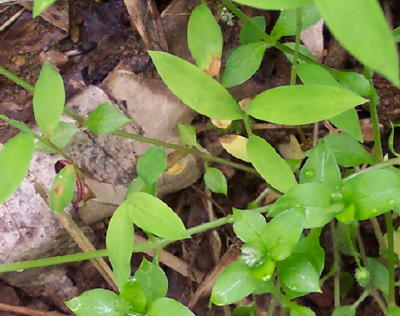
Japanese stiltgrass in many parts of Calhoun, Wirt
and Roane Counties started to die from Bipolaris
fungus almost as soon as they germinated this spring.
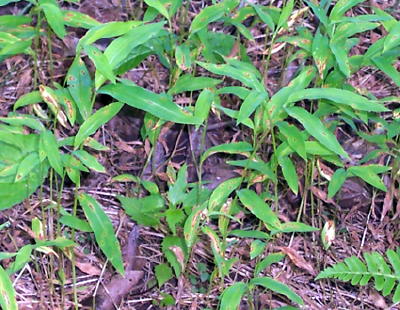
By early June Japanese stiltgrass in some Calhoun locations
was more dead than alive and native herbaceous plants were
having their first opportunity in years to grow without having
to compete with stiltgrass for sunlight, water or growing space.
Interest in the Bipolaris fungus has been very high and researchers from Indiana and the US Forest Service are expected to visit the area later in the summer to look more closely at the disease.
Excitement over the potential use of the disease to control stiltgrass invasions is very high with landowners, conservationists and forester managers from as far away as New York and Virginia requesting samples of locally diseased plants and old stiltgrass thatch to see if they can get the disease started in infestations on their own property.
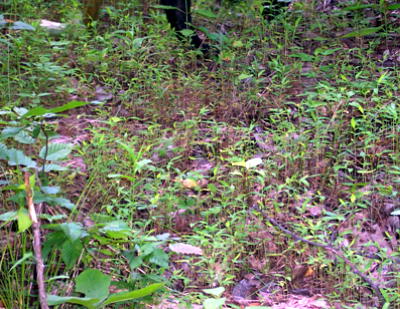
In a woodlot located off Nicut Road, an area with a forest floor
that had a nearly complete cover of waist high stiltgrass in the
summer 2009 had almost no healthy stiltgrass plants by mid June of
this year. In some locations where the disease has been active for
a couple years no healthy Japanese stiltgrass plants can be found.
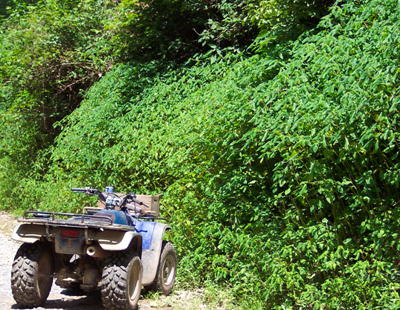
Scattered jewel weed, a common local plant was barely visible
above the stiltgrass on this road bank last summer. This year,
the stiltgrass showed signs of the disease early in the growing
season and the jewel weed has taken over the area towering almost
five feet over the mostly dead three inch tall stiltgrass plants.
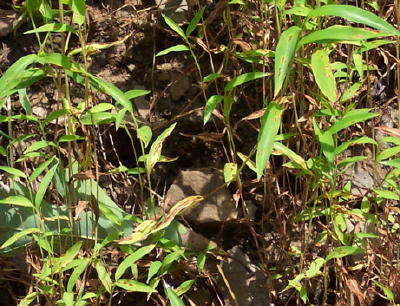
During mid July, healthy Japanese stiltgrass can average up to three
feet tall and grow so thick that it is often difficult to see your
feet below your knees. Property owners who spot places where it is
easy to see the ground through stiltgrass plants have a very good
indication that their stiltgrass is infected with Bipolaris fungus.